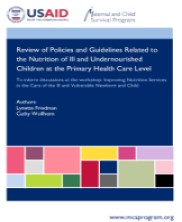Preventing morbidity and mortality in children under 5 years of age is an important shared priority for child health and nutrition stakeholders. While pneumonia, diarrhea, and malaria remain the leading immediate global causes of child death, the vulnerability to and the severity of these illnesses are exacerbated by undernutrition, which is a contributing factor in 45% of all under-5 deaths.1 The early years of a child’s life are particularly critical, and inadequate nutrition, suboptimal management for feeding problems and/or malnutrition, and poor feeding practices during this time period increase a child’s risk of falling ill or dying.
Among the global health community, the importance of nutrition throughout the life course of a child, from infancy through early childhood and adolescence, is gaining more attention. In the 5 years since the Maternal and Child Undernutrition Series was published in The Lancet, there has been a substantial increase in commitment to reduction of malnutrition at global and national levels.2 This includes the launching of the United Nations (UN) secretary-general’s Global Strategy on Women’s, Children’s and Adolescents’ Health (2016–2030); the Sustainable Development Goals; and the adoption of six global nutrition targets.3 Despite the growing focus on nutrition, there is significant concern about the level of integration of interventions focusing on nutrition and the treatment of childhood illness. More specifically, there is a concern that many primary health care providers or community health workers (CHWs) fail to recognize malnutrition—including stunting, wasting, micronutrient deficiencies, and overweight/obesity—in children while diagnosing and treating illness, or fail to provide appropriate nutritional care to children and counseling to caregivers of children with illnesses, therefore increasing the risk of malnutrition, mortality, or morbidity.
In addition, there are concerns about the poor optimization of opportunities to strengthen the counseling and follow-up of high-risk newborns and infants to promote breast milk and appropriate feeding. This report was compiled by JSI in 2020.


